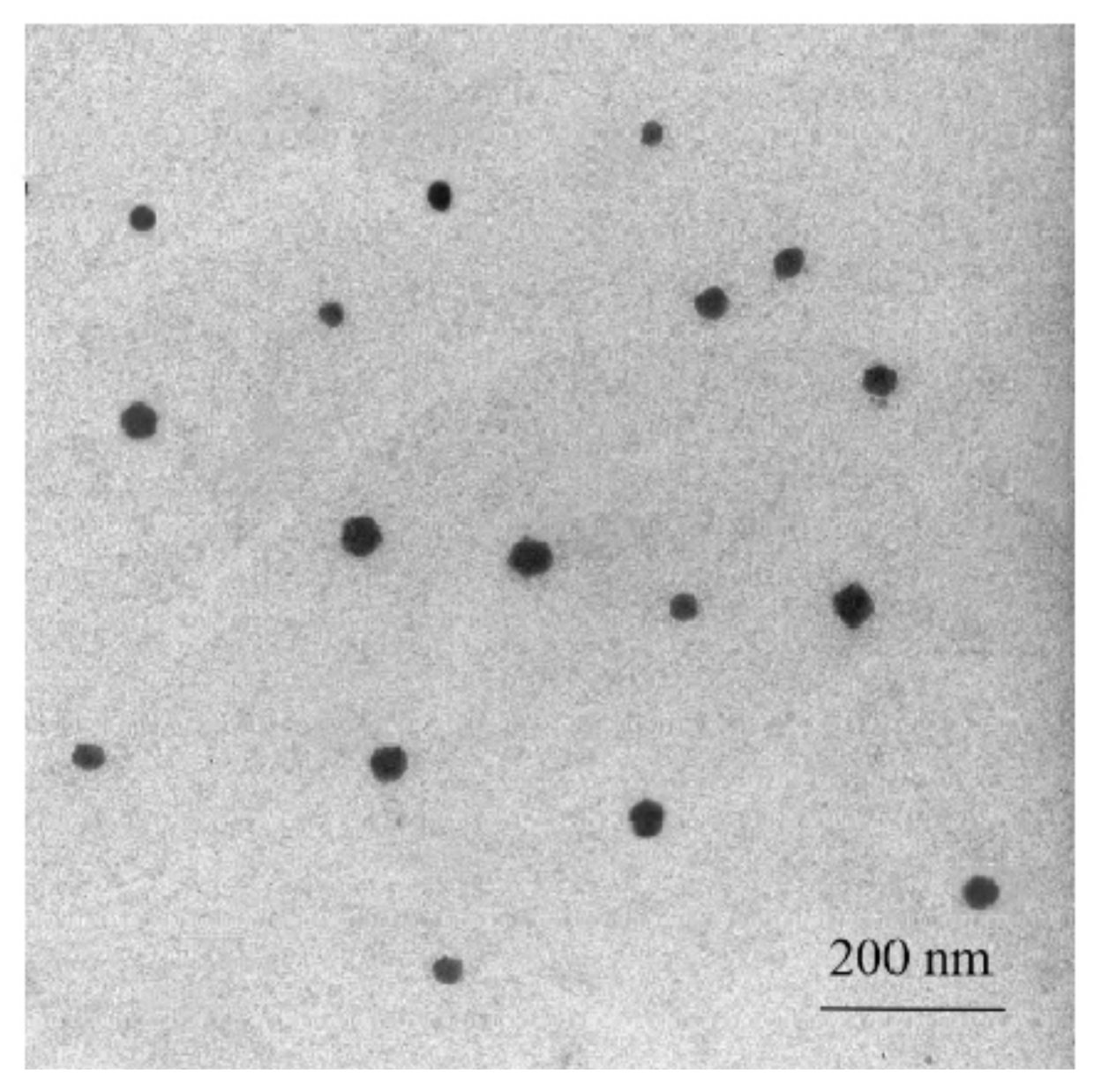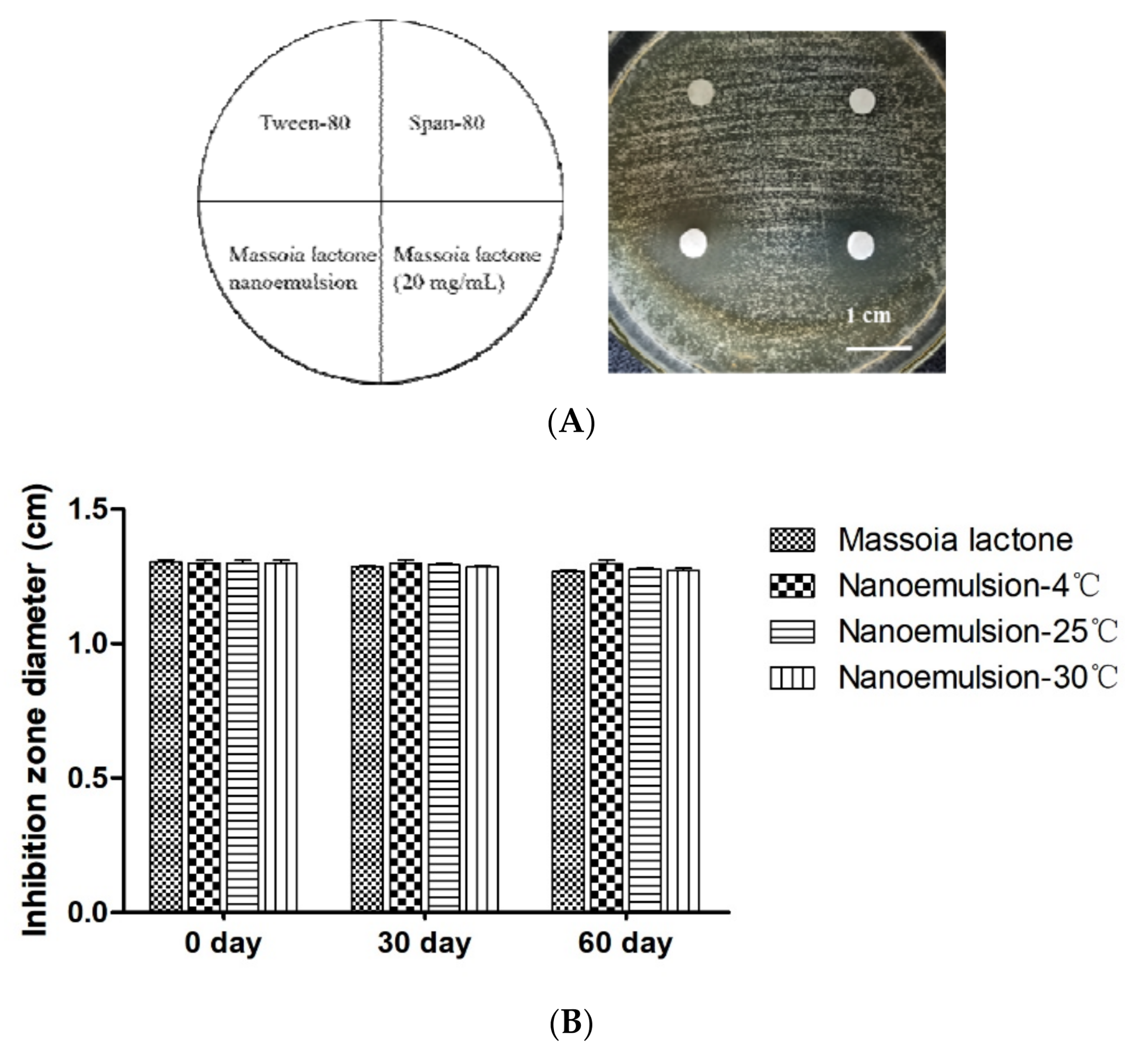Making of Massoia Lactone-Loaded and Food-Grade Nanoemulsions and Their Bioactivities against a Pathogenic Yeast
Abstract
:1. Introduction
2. Materials and Methods
2.1. The Fungal Strains and Materials
2.2. Preparation of Massoia Lactone-Loaded and Food-Grade Nanoemulsions (NEs)
2.3. Transmission Electron Microscopy
2.4. Measurements of Mean Droplet Diameters and Polydispersity Indexes
2.5. Physical and Chemical Stability of the Massoia Lactone-Loaded NEs
2.6. Anti-Fungal Activity of the Massoia Lactone-Loaded NEs
2.7. The Treated and Untreated Cells Were Stained with PI and the Annexin V-FITC
2.8. Determination of Antioxidant Activity
2.9. Assay of Scavenging Rate of Hydroxyl Radical
3. Results and Discussion
3.1. Preparation of the Massoia Lactone-Loaded and Food-Grade NEs

3.2. Stability of the Prepared Massoia Lactone-Loaded NEs
3.2.1. Stability of the Prepared Massoia Lactone-Loaded NEs during the Storage at Different Temperatures
3.2.2. Stability of the Prepared Massoia Lactone-Loaded NEs during the Centrifugation Process
3.2.3. Stability of the Prepared Massoia Lactone-Loaded NEs during the Dilution Process
3.3. Anti-Fungal Activity of the Massoia Lactone-Loaded NEs
3.4. Anti-Oxidant Activity of the Massoia Lactone Loaded NEs
3.5. Massoia Lactone Loaded in NEs Could Damage the Cell Membrane and Cause Cellular Necrosis of the Pathogenic Yeast
4. Conclusions
Supplementary Materials
Author Contributions
Funding
Informed Consent Statement
Data Availability Statement
Acknowledgments
Conflicts of Interest
References
- Kang, X.X.; Jia, S.L.; Wei, X.; Zhang, M.; Liu, G.L.; Hu, Z.; Chi, Z.; Chi, Z.M. Liamocins biosynthesis, its regulation in Aureobasidium spp., and their Bioactivities. Crit. Rev. Biotechnol. 2022, 42, 93–105. [Google Scholar] [CrossRef] [PubMed]
- Xue, S.L.; Liu, G.L.; Chi, Z.; Jiang, H.; Hu, Z.; Chi, Z.M. Genetic evidences for the core489 biosynthesis pathway, regulation, transport and secretion of liamocins in yeast-like fungal cells. Biochem. J. 2020, 477, 887–903. [Google Scholar] [CrossRef] [PubMed] [Green Version]
- Saika, A.; Fukuoka, T.; Mikome, S.; Kondo, Y.; Habe, H.; Morita, T. Screening and isolation of the liamocin-producing yeast Aureobasidium melanogenum using xylose as the sole carbon source. J. Biosci. Bioeng. 2020, 129, 428–434. [Google Scholar] [CrossRef] [PubMed]
- Zhang, H.Q.; Chi, Z.; Liu, G.L.; Zhang, M.; Hu, Z.; Chi, Z.M. Metschnikowia bicuspidate associated with a milky disease in Eriocheir sinensis and its effectitve treatment by Massoia lactone. Microbiol. Res. 2021, 242, 126641. [Google Scholar] [CrossRef]
- Tang, R.R.; Chi, Z.; Jiang, H.; Liu, G.L.; Chi, Z.M. Overexpression of a pyruvate carboxylase gene enhances extracellular liamocin and intracellular lipid biosynthesis by Aureobasidium melanogenum M39. Proc. Biochem. 2018, 69, 64–74. [Google Scholar] [CrossRef]
- Kishimoto, N.; Sugihara, S.; Mochida, K. In vitro antifungal and antiviral activities of γ- and δ-lactone analogs utilized as food flavoring. Biocontr. Sci. 2005, 10, 31–36. [Google Scholar] [CrossRef]
- Kurosawa, T.; Sakai, K.; Nakahara, T. Extracellular accumulation of the polyol lipids 3,5-dihydroxydecanoyl and 5-hydroxy-2-decenoyl esters of arabitol and mannitol by Aureobasidium sp. Biosci. Biotechnol. Biochem. 1994, 58, 2057–2060. [Google Scholar] [CrossRef]
- Barros, M.E.S.B.; Freitas, J.C.R.; Oliveira, J.M. Synthesis and evaluation of (-)-Massoia lactone and analogues as potential anticancer and anti-inflammatory agents. Eur. J. Med. Chem. 2014, 76, 291–300. [Google Scholar] [CrossRef]
- Sang, Q.; Pan, Y.; Jiang, Z. HPLC determination of massoia lactone in fermented Cordyceps sinensis mycelium Cs-4 and its anticancer activity in vitro. J. Food Biochem. 2020, 44, e13336. [Google Scholar] [CrossRef]
- Soundararajan, V.; Kandasamy, V.; Subramani, P. Antibiofilm, antioxidant and larvicidal activity of formulated nanoemulsion from Ocimum tenuiflorum. Mat. Today Proceed. 2021, 45, 3438–3443. [Google Scholar] [CrossRef]
- Rao, J.; McClements, D.J. Food-grade microemulsions and nanoemulsions: Role of oil phase composition on formation and stability. Food Hydrocoll. 2012, 29, 326–334. [Google Scholar] [CrossRef]
- Hong, L.; Zhou, C.L.; Chen, F.P.; Han, D.; Wang, C.Y.; Li, J.X. Development of a carboxymethyl chitosan functionalized nanoemulsion formulation for increasing aqueous solubility, stability and skin permeability of astaxanthin using low-energy method. J. Microencapsulat. 2017, 34, 707–721. [Google Scholar] [CrossRef]
- Jiang, L.; Zhang, M.; Meng, Z.; Xie, M. Honokiol kills Candida albicans through ROS accumulation and cell membrane destruction. Acta Microbiol. Sin. 2018, 58, 511–519. [Google Scholar]
- Shao, L.L.; Xu, J.; Shi, M.J.; Wang, X.L.; Li, Y.T.; Kong, L.M.; Hider, R.C.; Zhou, T. Preparation, antioxidant antimicrobial evaluation of hydroxamated degraded polysaccharides from Enteromorpha prolifera. Food Chem. 2017, 237, 481–487. [Google Scholar] [CrossRef] [Green Version]
- Rai, V.K.; Mishra, N.; Yadav, K.S.; Yadav, N.P. Nanoemulsion as pharmaceutical carrier for dermal and transdermal drug delivery: Formulation development, stability issues, basic considerations and applications. J. Contr. Rel. 2018, 270, 203–225. [Google Scholar] [CrossRef] [PubMed]
- Yang, R.; Miao, J.; Shen, Y.; Cai, N.; Wan, C.; Zou, L. Antifungal effect of cinnamaldehyde, eugenol and carvacrol nanoemulsion against Penicillium digitatum and application in postharvest preservation of citrus fruit. LWT Food Sci. Technol. 2021, 141, 110924. [Google Scholar] [CrossRef]
- Figen, T.; Seyda, A.; Nevin, C. Nanoemulsions as Drug Delivery Systems. In Colloids in Drug Delivery; Fanun, M., Ed.; CRC Press: Boca Raton, FL, USA, 2010; pp. 221–244. [Google Scholar]
- Koroleva, M.Y.; Evgenii, V.Y. Nanoemulsions: The properties, methods of preparation and promising applications. Rus. Chem. Rev. 2012, 81, 21. [Google Scholar] [CrossRef]
- Liu, W.; Sun, D.; Li, C.; Liu, Q.; Xu, J. Formation and stability of paraffin oil-in-water nano-emulsions prepared by the emulsion inversion point method. J. Colloid Interf. Sci. 2006, 303, 557–563. [Google Scholar] [CrossRef]
- Hoeller, S.; Sperger, A.; Valenta, C. Lecithin based nanoemulsions: A comparative study of the influence of non-ionic surfactants and the cationic phytosphingosine on physicochemical behaviour and skin permeation. Internt. J. Pharm. 2009, 370, 181–186. [Google Scholar] [CrossRef]
- Pund, S.; Shete, Y.; Jagadale, S. Multivariate analysis of physicochemical characteristics of lipid based nanoemulsifying cilostazol-quality by design. Colloids Surf. B Biointerf. 2014, 115, 29–36. [Google Scholar] [CrossRef]
- Mishra, N.; Yadav, K.S.; Rai, V.K.; Yadav, N.P. Polysaccharide encrusted multilayered nano-colloidal system of andrographolide for improved hepatoprotection. AAPS Pharm. Scient. Technol. 2017, 18, 381–392. [Google Scholar] [CrossRef]
- Klinkesorn, U.; McClements, D.J. Influence of chitosan on stability and lipase digestibility of lecithin-stabilized tuna oil-in-water emulsions. Food Chem. 2009, 114, 1308–1315. [Google Scholar] [CrossRef]
- Aoki, T.; Decker, E.A.; McClements, D.J. Influence of environmental stresses on stability of O/W emulsions containing droplets stabilized by multilayered membranes reduced by a layer-by-layer electrostatic deposition technique. Food Hydrocol. 2005, 19, 209–220. [Google Scholar] [CrossRef]
- Li, Y.; Hu, M.; Xiao, H.; Du, Y.; Decker, E.A.; McClements, D.J. Controlling the functional performance of emulsion-based delivery systems using multi-component biopolymer coatings. Eur. J. Pharm. Biopharma. 2010, 76, 38–47. [Google Scholar] [CrossRef]
- Sutradhar Kumar, B.; Amin, L. Nanoemulsions: Increasing possibilities in drug delivery. Eur. J. Nanomed. 2013, 97, 237–245. [Google Scholar] [CrossRef]
- Sugumar, S.; Ghosh, V.; Nirmala, M.L.; Mukherjee, A.; Chandrasekaran, N. Ultrasonic emulsification of eucalyptus oil nanoemulsion: Antibacterial activity against Staphylococcus aureus and wound healing activity in Wistar rats. Ultrason. Sonochem. 2014, 21, 1044–1049. [Google Scholar] [CrossRef] [PubMed]
- Laxmi, M.; Bhardwaj, A.; Mehta, S.; Mehta, A. Development and characterization of nanoemulsion as carrier for the enhancement of bioavailability of artemether. Artif. Cell. Nanomed. Biotechnol. 2014, 43, 334–344. [Google Scholar] [CrossRef]
- Singh, Y.; Meher, J.G.; Raval, K.; Khan, F.A.; Chaurasia, M.; Jain, N.K. Nanoemulsion: Concepts, development and applications in drug delivery. J. Cont. Relea. 2017, 252, 28–49. [Google Scholar] [CrossRef]
- Tubtimsri, S.; Limmatvapirat, C.; Limsirichaikul, S.; Akkaramongkolporn, P.; Piriyaprasarth, S.; Patomchaiviwat, V. Incorporation of fixed oils into spearmint oil-loaded nanoemulsions and their influence on characteristic and cytotoxic properties against human oral cancer cells. J. Drug Deliv. Sci. Technol. 2021, 63, 102443. [Google Scholar] [CrossRef]
- Gulcin, I. Antioxidant activity of food constituents: An overview. Arch. Toxicol. 2012, 86, 345–391. [Google Scholar] [CrossRef]
- Schlesier, K.; Harwat, M.; Bohm, V. Assessment of antioxidant activity by using different in vitro methods. Free Rad. Res. 2002, 36, 237–242. [Google Scholar] [CrossRef] [PubMed]
- Dawidowicz, A.L.; Olszowy, M.; Magorzata, J.D. Importance of solvent association in the estimation of antioxidant properties of phenolic compounds by DPPH method. J. Food Sci. Technol. 2015, 52, 4523–4529. [Google Scholar] [CrossRef] [PubMed] [Green Version]





Publisher’s Note: MDPI stays neutral with regard to jurisdictional claims in published maps and institutional affiliations. |
© 2022 by the authors. Licensee MDPI, Basel, Switzerland. This article is an open access article distributed under the terms and conditions of the Creative Commons Attribution (CC BY) license (https://creativecommons.org/licenses/by/4.0/).
Share and Cite
Yuan, L.; Zhang, H.-Q.; Chi, Z.; Liu, G.-L.; Chi, Z.-M. Making of Massoia Lactone-Loaded and Food-Grade Nanoemulsions and Their Bioactivities against a Pathogenic Yeast. J. Mar. Sci. Eng. 2022, 10, 339. https://doi.org/10.3390/jmse10030339
Yuan L, Zhang H-Q, Chi Z, Liu G-L, Chi Z-M. Making of Massoia Lactone-Loaded and Food-Grade Nanoemulsions and Their Bioactivities against a Pathogenic Yeast. Journal of Marine Science and Engineering. 2022; 10(3):339. https://doi.org/10.3390/jmse10030339
Chicago/Turabian StyleYuan, Li, Hong-Qian Zhang, Zhe Chi, Guang-Lei Liu, and Zhen-Ming Chi. 2022. "Making of Massoia Lactone-Loaded and Food-Grade Nanoemulsions and Their Bioactivities against a Pathogenic Yeast" Journal of Marine Science and Engineering 10, no. 3: 339. https://doi.org/10.3390/jmse10030339





